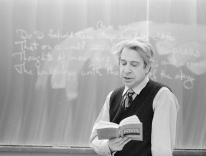
“A book comes to find you at a particular season of your life. Afterwards, nothing is the same.” So writes Michelle de Kretser in her slim, spectacular book of criticism On Shirley Hazzard. Many will recognize the kind of transformative reading experience that de Kretser, the author of five novels herself, describes here. For me, Marilynne Robinson’s Gilead was such a book. I needed it; it came to find me; everything seemed different afterwards. For de Kretser, the book that caused the scales to drop from her eyes was Shirley Hazzard’s The Bay of Noon.
Hazzard, an Australian-American novelist who died in 2016, is best known for The Great Fire, a lush, elliptical work of historical fiction and winner of the 2003 National Book Award, and The Transit of Venus, an almost unfathomably gorgeous novel published in 1980. (She was also great friends with Graham Greene; Greene on Capri is her light- and sea- and food- and drink-filled memoir of their years vacationing together.) De Kretser’s introduction to Hazzard, The Bay of Noon, attends to beautiful things—Italy, romance, painting, poetry—and it created in its reader “the rush of gratitude: that such writing existed, that it had come my way.” She delights in the book’s precise, vibrating details, and remembers how she read it:
The greedy, gulping way I read The Bay of Noon—a child devouring sweets—returned me to childhood and whole days spent deep in fictional worlds. It was reading as a form of enchantment, a way of reading I continue to value and need. There are novels that, like beloved people, stand between us and the world. They do this by altering our relation to time. They pass through it. They render time irrelevant.
On Shirley Hazzard, the result of de Kretser’s decades of reading Hazzard’s work, is a love note from one spectacular writer to another. This love arose at least in part due to biographical circumstance. Both writers are Australian, though both have felt, as de Kretser puts it, a “question mark…hover[ing] over our right to be considered Australian: in her case, because she left the country at the age of sixteen; in mine, because I didn’t arrive until I was fourteen.” (De Kretser was born in Sri Lanka; Hazzard moved in her teenage years to Hong Kong, then to New Zealand, then to the United States, then to Italy.)
But the affinity between de Kretser and Hazzard also comes from a shared style—a tendency toward the sumptuous and painterly, the surprising verb and electrifying adjective. Neither seems capable of writing a boring sentence, and one of the joys of reading this book is seeing one splendid stylist marveling at the stylistic splendor of another. De Kretser quotes liberally and with obvious love on every page. Some of my favorites of de Kretser’s favorites: Hazzard noting “the hard apple” of a cat’s head; Hazzard describing the “mad grin” of lightning; Hazzard seeing “a bathroom varicose with streaked marble.”
“Quotation seems the best way of indicating what I admire in Hazzard,” de Kretser writes. It also seems the best way of indicating what I admire in On Shirley Hazzard. Here is de Krester on Hazzard’s sentence rhythms:
[Hazzard] often ends a sentence with a stressed monosyllable: “The decline of a sea-girt house offers no phase of seedy charm.” The effect is not simply of closing a door, but of shooting the bolt home. The sentence is sealed.
And here she is on the jolt offered by good writing:
Language is examined up close in Hazzard’s work. “We are human beings, not rational ones.” The stock phrase “human beings” is disrupted by isolating its first element; the mind receives a little jolt.
On Shirley Hazzard
Michelle de Kretser
Catapult
$14.95 | 112 pp.
As The Bay of Noon was to Michelle de Kretser, so The Bill James Historical Baseball Abstract has been to many a baseball nerd, myself included.
First published in 1985 and revised on several occasions since then, James’s book helped bring about baseball’s analytic turn—a movement away from intangibles like “grit” and “clutch ability” toward a focus on metrics that can be measured quantifiably and that contribute directly to the creating and saving of runs. Detractors, and there are many, claim that analytics drains baseball of its magic, understanding players as automatons and success as computer generated. Defenders, and there are just as many, insist that seeing the game more clearly allows for a deeper appreciation of its history and heroes.
Christopher Beha’s new novel, The Index of Self-Destructive Acts, takes its title from a Bill James concept. One of James’s key insights was that pitchers control the action a lot less than we think they do: once a ball is put into play, it is largely luck, not a pitcher’s skill, that determines whether it becomes a hit or not. Therefore, pitchers can maximize success by controlling the few things they do control. James’s “index of self-destructive acts” calculates how often a pitcher fails at this, totaling up how many times he balks, hits a batter, throws a wild pitch, or makes an error. The index, in other words, charts the many ways of self-sabotage. So too does the realist novel, and it’s one of the many things that Beha, the editor of Harper’s and the author of two previous novels, does well in his new book.
The Index of Self-Destructive Acts contains many moving parts, taking on racial politics in the age of Obama (it begins in April 2009), the nature of writerly ambition, and the grift that is high-risk financial capitalism. It’s also, as befits its title, a novel about baseball. One main character, an old-school public intellectual and man of letters named Frank Doyle, writes regularly on the Mets until he’s fired for making a drunken, racist comment on a national broadcast. Another, a Nate Silver–like figure named Sam Waxworth, applies analytics not just to politics but to sports. The two argumentatively parry and thrust about baseball and statistics while watching a game at Citi Field. Mets supporters will want to cover their eyes at memories of the team’s 2008 collapse and José Reyes’s overrated defense. Fans of baseball history will relish Frank recalling the “ferocious grace” with which Jackie Robinson moved.
In one passage, Frank riffs on the moment when a fan gets on the Jumbotron and has to decide where to look.
This incited a strange dilemma: if you looked into the lens and properly played the part of screaming celebrant, the camera would linger on the performance, but you would never see it; alternatively, if you looked up at the screen to witness your public moment, you saw only a face looking distractedly up at the screen until the camera hurried on to someone who would better inhabit the role. Most fans attempted to split the difference, shifting back and forth between the two, working themselves into a kind of frenzy as they attempted to turn quickly enough to catch themselves on the screen still looking at the camera.
You know from this passage that Beha is a fan, that he’s been to Citi Field, that he’s observed this spectacle of Jumbotron-sized self-reflexivity firsthand.
The next paragraph slides into broader speculations: “Without the crowd, the game had no meaning—as Wittgenstein said, The sense of the world must lie outside the world—but the game must proceed as though the crowd wasn’t there. What was needed was some recording angel, taking it all down in a book somewhere, making it all comprehensible, and you could not be both the actor and the recorder.” There’s much to unpack: the idea that significance, whether you’re talking about a game or a life or a world, arises not from within but from without; the related suggestion that these things—games and lives and worlds—have no meaning until they have ends; the implication that to talk about meaning means, on some level, to talk about God. This is heady stuff: in addition to Wittgenstein, I sense the ideas of Frank Kermode and George Steiner dancing in the background. As Frank’s daughter Margo observes, “engaging seriously with ideas was one of life’s great adult pleasures.” It’s also one of the great pleasures of reading Beha’s novel.
Each of these claims—about endings and God and meaning-making—radiate out across the novel’s many non-baseball-related strands: an apocalyptic street preacher who proclaims that the world is coming to an end; Margo, an English graduate student, who is “interested in Romanticism as a response to some of the problems that come with secularism”; a young woman whose body is failing and who feels that “things have stopped meaning”; Sam Waxworth, who uses statistics to “discern some order hidden within the mess of the world.”
All of which is to say, this is a sprawling novel that feels thematically tight, a work in the best tradition of literary realism that also thinks about large-scale theological and aesthetic issues. It has first-rate passages on the gifts offered by memorizing poetry (“There’s something different about having it inside you”) and on PhD programs (“Professional ambition had long been the academic’s dirty secret; today the dirty secret was that you just loved to read”) and on gentrification and on belief. To use the kind of old-fashioned sports cliché that Bill James would hate, The Index of Self-Destructive Acts swings for the fences. I’m happy to report that it connects.
The Index of Self-Destructive Acts
Christopher Beha
Tin House Books
$27.95 | 517 pp.
One of Beha’s characters describes the experience of reading Robert Frost’s “After Apple-Picking” and learning that, while the poem was about a man picking apples and falling asleep, it also was “about something else, something more”: “And so it wasn’t really right to say that the poem was about something other than what it pretended to be, only that it was about many things at the same time.” That’s one decent definition of a good poem: something that means many things at the same time.
For decades now, Rosanna Warren has been one of America’s strongest poets. Her latest collection, So Forth, displays her regular gifts: learnedness, beauty, versatility, range of form and tone, a chameleon-like ability to change style from poem to poem, even stanza to stanza.
As always, Warren, a gifted translator, writes out of and toward tradition. (A suite of six poems called “Legende of Good Women” channels past female artists, including the fellow poet and translator Mary Sidney and the harpsichordist Sylvia Marlowe.) And as always, she writes masterfully about nature, as in the opening to “For Chiara”: “Leaves crackle beneath our feet—tinder, kindling— / as we walk by the brook, the crab apple tree / a crimson pointillist nimbus.” Warren is a painter as well as a poet, and she sketches this scene exquisitely. But she also creates the scene musically, through assonance (leaves/beneath/feet; tinder/kindling) and internal rhyme (walk/brook; we/tree). Poet, painter, musician: Warren makes words mean many things at once.
So Forth, Warren’s sixth collection, is studded with such moments of pointillist precision. In “Cotillion Photo,” we get this memory: “I remember July sun pouring down / in a prickly meadow, and a garter snake skin / laid out like fairy lingerie on a stone wall. / This was Connecticut, there would be a stone wall. / Crickets were scraping marrow from the day.” I challenge you to see snake skin or hear crickets the same ever again. In “At Villeneuve-lès-Maguelone,” we get this seaside moment: “Salt sears each wave, / sand crusts your eyebrows and the rim of each ear / and the sun licks hunchbacked breakers with a tongue of fire.” The assonance and alliteration of “Salt sears each wave,” the crackling sound of “licks hunchbacked breakers”: what perfect music. Another poem, “Fourth of July, 2018,” begins in sleep and ends with this waking vision: “And the trees, / short of breath, gesture vaguely, / exhausted women with ponderous bathroom sleeves.”
But before we get the trees we get the dream: “‘Police state, / Police state,’ the dream declares, twisting damp sheets”; “The dream wakes and stutters, ‘Camps, / children in camps,’ as the sky turns powdery white.” Except the children aren’t in camps just in our dreams. They’re in camps in our waking hours, too, and So Forth registers the wounds of our body politic as well as the wounds of our plain old bodies. The speaker of “Scenic View” goes to the doctor and “the ultrasound reveals / black and white galaxies aswirl in my breast, / streams of stars, dazed planets, a loose comet here and there.” In “The Mink,” the speaker thinks back to hours spent walking “a stony spit out into the North Atlantic / with a young man I hardly knew, and his sister. / He was bald, dying / of a brain tumor. I ignored / his illness and we spoke of history.” Years later, the long-dead boy returns to her: “So history bounds / into the present, glitter-eyed, with musky anal glands / and daggering eye teeth.”
“We’re all melting,” Warren writes in “Glaucoma.” “This house is not our own. / Daily, my vision fails.” Signs of transience, of time passing and past, abound: a “shack collapsing / season by season,” as the “floor / buckles, clapboards sag, wires hang askew / like muscles in a bungled autopsy”; riding the train by Long Island Sound, we see “a dilapidated barge, half-sunk,” along with the “tumble of trash down a bank— / my country, my countryside, hurls itself away.” Time hurls us away, breaking our bodies down. But we also hurl ourselves and our world away, consuming and destroying as we go.
Despite all this, something abides. So Forth describes the movement of everything and everyone toward dissolution but counters it with the lastingness of form and pattern: “Translate us too, rough line by line, / into your crystalline / severe design.” It charts the body’s losses as well as the rigor with which we resist them—through loving, working, reading, creating. To quote Warren quoting the painter Gwen John, “We must go on with our mysterious work.”
So Forth
Rosanna Warren
W. W. Norton & Company
$25.95 | 96 pp.
Please email comments to [email protected] and join the conversation on our Facebook page.
Previous Story
Gone Viral
Next Story
Sheltering in Place


